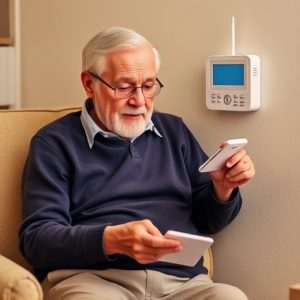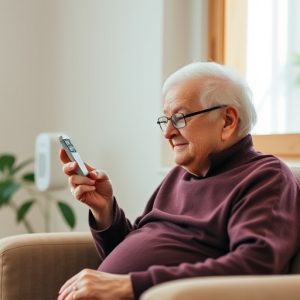Enhancing Senior Safety: A Guide to Personal Alarm Systems
Personal alarm systems for the elderly have become a crucial tool for enhancing safety and promoting…….
Personal alarm systems for the elderly have become a crucial tool for enhancing safety and promoting independence among seniors. These wearable devices, often in the form of pendants or wristbands, allow users to quickly contact family members, caregivers, or emergency services at the press of a button, significantly reducing response times during emergencies. Key features of effective systems include a wide alert range, user-friendly operation with a simple activation process, and reliable connectivity through landline, mobile network, or Wi-Fi. Advanced options like fall detection can automatically send alerts if a fall is detected, while two-way voice communication facilitates immediate assistance. For seniors who are active and may require help outside the home, a personal alarm system with GPS tracking is highly recommended to ensure support regardless of location. Studies have shown that these systems effectively prevent falls and reduce associated injuries by promptly alerting caregivers or emergency services, providing peace of mind for both the elderly and their families. These alarm systems are integral in enabling seniors to age in place, preserving a high quality of life with the assurance of constant support.
As our population ages, ensuring the safety and autonomy of seniors becomes increasingly paramount. A personal alarm for the elderly can be a crucial tool in this endeavor. This article delves into the necessity of such systems, detailing their features and the benefits they offer. We explore how these alarms empower the aging to maintain independence while providing families with a vital safeguard against accidents and emergencies. Through case studies, we’ll illustrate the real-world impact of personal alarm systems on elderly well-being and the reassurance they bring to loved ones. Understanding the importance of staying connected and secure, this discussion underscores the significance of a personal alarm for elderly individuals in safeguarding their dignity and enhancing their quality of life.
Understanding the Need for Personal Alarm Systems for the Elderly
The advent of ageing populations across the globe has necessitated the development of technologies that enhance the safety and independence of senior citizens. Personal alarm systems for the elderly have emerged as a critical tool in this regard, offering a reliable means of assistance in case of emergencies. These devices are designed to provide immediate help at the push of a button, connecting the user with family members, caregivers, or emergency services when they need it most. The primary function of these alarms is to monitor and detect falls or other critical incidents, which can significantly reduce response times and improve the outcome for seniors who might otherwise be left unattended for extended periods.
Moreover, the integration of personal alarm systems into daily life allows elderly individuals to maintain their autonomy and continue living in familiar surroundings, rather than transitioning to assisted living facilities. The psychological benefits of ageing in place with these safety nets are substantial, as they can alleviate anxiety related to personal safety and the fear of becoming a burden. These systems also offer peace of mind to family members, who may be geographically distant but can still be assured that their loved ones have access to immediate assistance. The implementation of personal alarm systems is a responsive step in addressing the growing needs of our ageing population, ensuring they can live safely and with dignity in their own homes.
Features to Consider When Selecting a Personal Alarm System for Seniors
When selecting a personal alarm system tailored for the elderly, it’s crucial to consider a variety of features that prioritize safety, usability, and accessibility. The first feature to evaluate is the alert range, which determines how far the device can transmit a signal in case of an emergency. A robust system should offer a range sufficient to cover the entire living space and immediate surroundings. Additionally, the system should be easy to operate; seniors should be able to activate an alarm with simple steps, ideally using a single button, to alert family members or emergency services if needed.
Another important aspect is the system’s connectivity options. Whether through landline, mobile network, or Wi-Fi, the personal alarm should reliably transmit alerts. Some systems also offer fall detection technology, which can automatically send an alert if the user experiences a fall, providing an added layer of protection for those at risk of injury. Features like two-way voice communication can also be invaluable, allowing for immediate dialogue with the monitoring center or loved ones. Waterproof pendants or wristbands ensure that help is always accessible even during bathroom visits or other activities where the risk of falling is higher. Lastly, consider a system that includes GPS tracking for seniors who are more mobile and may require assistance outside their home as well. These features collectively contribute to a comprehensive personal alarm system that supports the safety and independence of elderly individuals in their daily lives.
How Personal Alarm Systems Enhance Safety and Independence for the Aging Population
Personal alarm systems represent a significant advancement in enhancing the safety and independence of the aging population. These devices are designed to be worn by the individual, typically as a pendant or wristband, allowing for immediate access to emergency assistance at the press of a button. In the event of a fall or medical emergency, the system automatically alerts pre-set contacts, such as family members or caregivers, and, if necessary, emergency services, ensuring prompt response times. This reliability offers peace of mind not only to seniors but also to their loved ones, who can rest assured that help is readily available should it be needed.
Moreover, these systems are equipped with features that cater to the unique needs of older adults, including fall detection technology and two-way voice communication. Fall detection, in particular, is a crucial aspect as it can automatically detect when an individual has fallen and send an alarm without the need for the user to manually activate the device. The two-way voice feature allows users to communicate directly with emergency operators through the device, reducing the need for the user to reach a phone or call out for help. These systems empower seniors to maintain their independence by assuring them that support is accessible at all times, fostering an environment where they can continue living in their own homes with confidence and security.
Case Studies: The Impact of Personal Alarm Systems on Elderly Lives and Families' Peace of Mind
Personal alarm systems for the elderly have proven to be a transformative technological solution in ensuring the safety and security of seniors living independently. Case studies across various regions have consistently shown that these alarms provide a lifeline, enabling older adults to maintain their autonomy while offering families the peace of mind they need. For instance, a study conducted in a suburban community found that the introduction of personal alarm systems led to a notable reduction in accidental falls and associated injuries among the elderly population. The devices, equipped with fall detection technology, alerted caregivers or emergency services promptly, minimizing response times and significantly improving health outcomes for seniors.
Families of those using personal alarms reported feeling more at ease, knowing that their loved ones had a reliable means of assistance at their disposal. This heightened sense of security facilitated by the systems also allowed family members to live their daily lives with less anxiety, as they were assured that any emergency in the home of an elderly relative would be swiftly addressed. Furthermore, these alarms have been instrumental in fostering a sense of independence among seniors, who often express a preference for living in their own homes rather than moving to assisted living facilities. The peace of mind provided by personal alarm systems is not just a benefit for the elderly themselves but also for the extended family network, which remains closely connected and involved in their loved ones’ well-being.


